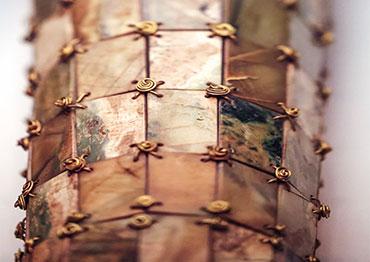Among the numerous tomb treasures, the most striking discovery was Liu Sheng’s elaborate jade burial suit. The 188 centimeter-long suit consists of thousands of jade pieces, meticulously sewn together with gold thread. Also known as “jade caskets,” jade burial suits served as garments for deceased emperors and nobles.
They were tailored to reflect rank. Emperors, esteemed nobles and officials wore garments sewn with gold thread. Suits for kings and princesses were threaded with silver, while other officials and nobles had suits stitched with copper.
The luxurious design originates from the ancient belief that jade could absorb the essence of mountains, possessing the power to prevent bodily decay. Jade burial suits were mentioned in written records as early as the Western Zhou Dynasty, approximately 3,000 years ago. However, for millennia, there had been no tangible evidence of their existence – until the discovery of the suit crafted for Liu Sheng.
A complete suit has six components: a head covering, upper garments, sleeves, gloves, trousers and shoes. Each part is crafted in various shapes of jade, all intricately designed and polished. Small holes are drilled near the corners of each piece allowing them to be woven into a suit.
Liu Sheng’s suit uses 2,498 jade pieces and 1,100 grams of gold thread. The suit is broader in the chest and back, and bulges in the hips, perfectly contouring the body. All bodily orifices were covered, including the eyes, nose, penis and anus. The mouth is covered with a cicada design, which signifies rebirth. A pig figurine covers the anus, symbolizing abundance in food and clothing.
Making such a suit is a complex process. Archaeologists theorize that ancient craftsmen tailored the suit on a wooden mannequin. They drew lines to divide the sections, then cut and shaped jade to fit each body part. Gold threads, typically 4 to 5 centimeters long, connected the pieces. The thinnest threads were no thicker than a strand of human hair.
Crafting Liu Sheng’s jade suit would have taken a skilled artisan over 10 years to complete, although several craftsmen were likely commissioned for the piece. It is estimated to have cost the equivalent total assets of 100 middle-class families during the Han Dynasty. So exorbitant and labor-intensive were the suits, the pragmatic Emperor Wen of the State of Wei banned them during the Three Kingdoms period around 200 CE.
As Han funerary tradition dictated couples be buried together, Guo Moruo deduced the tomb of Liu Sheng’s wife, Queen Dou Wan, would be located nearby. Identifying a similarly shaped hill roughly 100 meters away, the team indeed discovered Dou Wan’s tomb. Her resting place was even more spacious, and a second jade burial suit was discovered. Comprised of 2,160 jade pieces, the suit was stitched together using over 600 grams of gold thread.
Hebei Museum houses these two jade burial suits, which are the earliest and finest among the more than 20 relatively complete jade burial suits discovered in China to date.
Recognized as the largest, highest-ranking, and best-preserved royal tombs of early imperial China, the tombs of Liu Sheng and Dou Wan contained numerous national treasures, such as the Changxin Palace lantern and Boshan incense burner.
These artifacts showcase the excellence of ancient Chinese craftsmanship and offer insights into the religious beliefs, social nuances and political agendas of early imperial Chinese rulers.

 Old Version
Old Version





